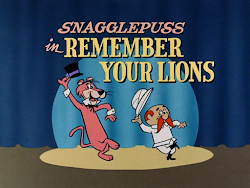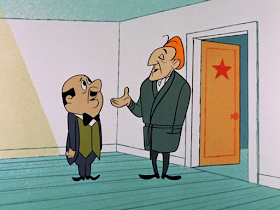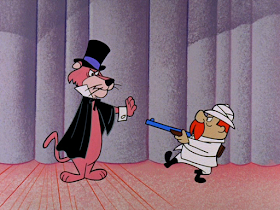![]()
The Huck show was practically an instant hit in the U.S., and Screen Gems didn’t waste time having it distributed in foreign countries (and dubbed into other languages where needed). Canada was just one English-speaking land where kids laughed and smiled over the antics of the blue dog and a meece-hating cat. So was the United Kingdom.
That brings us to this story in the London-based publication Television Mail, announcing what appears to be an expansion of Huck’s show in England, Scotland and Northern Ireland. It’s from the October 14, 1960 edition. There’s no byline, so the story could be from publicity materials. The last two paragraphs are pretty much what was contained in part of a United Press story quoting Joe Barbera published before this. (As an aside, Pattee Chapman’s name is mentioned. I can’t tell from the few samples of her voice that I’ve heard if she was the unidentified female voice in a few Yogi Bear cartoons during the 1958-59 season).
Oddly, there’s no mention of The Flintstones, which was already on the air in North America by this time. And Barbera gets positively philosophical about children wishing to travel back in time. That’s ironic as there are a number of adults who want to travel back to when they were children, waxing on about cereal, lamenting the death of cartoons on Saturday mornings (even though they haven’t watched TV then in maybe 20 years) and getting weepy about some animated series which, really, were not very good. There should be no such nostalgia for Huck, Yogi and their late ‘50s Hanna-Barbera compatriots. The cartoons still stand on their own as entertainment. After all, adults watched them, too, way back when.
For whatever odd reason, though the story is supposed to be about Huck and his show, the only drawing accompanying it was a set-up of Yogi Bear and Boo Boo from “Papa Yogi,” animated by George Nicholas.Huckleberry Hound Comes To ITVTELEVISION’S first exclusive cartoon character, Huckleberry Hound, has taken another big bite in the British market. A-R plans to show the Screen Gems series from October 21, with networking to Scotland and Ulster. Thirty-nine programmes will go out on Fridays at 5.25 p.m.
The Hound’s creators, Joe Barbera and Bill Hanna, used to sketch eight “Tom and Jerry” shorts a year. Now, to satisfy television’s enormous appetite, they turn out more than 150 cartoons annually.
Hanna and Barbera have built up a unique personality for each of a zoo of characters necessary to fill these films.
Copes with all“Like Huckleberry Hound himself,” explains Barbera. “He’s slow-moving but nothing floors him. He takes on bank robbers, dragons and amorous cocker spaniels with the same steady determination.”
Other personalities in the series include Yogi Bear, who continually tries to find some peace and quiet in a landscaped bedlam called Jellystone National Park. There there’s Mr. Jinks, a tomcat whose vocal inflections give evidence of his training at a “modern” acting school.
“A cartoon hero is never limited by restrictions of space or time,” explains Barbera. “Yogi Bear can take enough buckshot in his hide to lay out a dozen real bears, then laugh in the hunter’s face. Huck Hound is anything he wants to be—a cowboy or cave man.”
Barbera feels that this disrespect is what lends an animated cartoon its charm.
“By a time a youngster is old enough to think for himself he has discovered that life has pretty strict boundaries. Touch something hot and you get burnt. Hit your head on the floor and you raise a nasty bump.
“The child wishes it weren’t so. He would like to fly, travel back in time, or defeat a bully twice his size. But he can do these things only in fantasy. “In a cartoon, his fantasy is acted out before him—and he’s utterly delighted.”
Like many other TV creators, Hanna and Barbera began their career in motion pictures. Before turning their interests to video, the two producers had already made their mark with “Tom and Jerry.” Together, Hanna and Barbera turned out over 200 of these cat-and-mouse adventures for MGM. It won for them seven Academy of Motion Picture Arts and Sciences Oscars.
Hanna and Barbera Productions are now producing three TV cartoon series for Screen Gems, “Huckleberry Hound,” “Ruff and Ready,” [sic] and their newest cartoon brainchild, “Quick Draw McGraw.”
Oddly enough, neither Hanna nor Barbera began their careers as cartoonists or artists. The former graduated as an engineer, but tired of this work and took an art course before joining a cartoon studio. They met later when Barbera joined the organisation from his job as trust accountant. [Barbera left Irving Trust to work at Van Beuren and Terrytoons before meeting Hanna at MGM].
Twenty-one years after they teamed up the two men are still busily creating, and sharing the same office in one corner of a brick studio Charlie Chaplin built in Hollywood. The company today has more than 400 people on its payroll.
With producer-director George Sidney, Hanna and Barbera Productions was formed in 1957, with a handful of employees.
They entered TV at a time when it was considered impossible to produce original cartoons exclusively for television. The costly animation process remained a stumbling block. Consequently viewers of TV only saw old theatrical cartoons, many of which would fit into the economics of the medium—without sacrificing quality.
SimplifiedEmploying simplified processes, the Hanna-Barbera team brought the first successful original animation to television.
The two men looked over hundreds of pen and ink illustrations (all their own) until they came upon Huck. In this rawboned pooch was the mixture of not 12 breeds, but at least 30 canine blood lines.
After thousands of individual drawings of Huckleberry in various poses, and the voice of Daws Butler had been dubbed into the lungs of the canine creation, Huck was ready for his big moment.
Success has bred success, and some of the most sought-after thespians in Hollywood are experts in characterisations.
According to Barbera there is a real dearth of voices. People like Daws Butler, Don Messick, June Foray and Patty Chapman [sic] can name their terms and jobs, the demand for them is so acute. It stems from the new surge of cartoon production not only in TV cartoon shows but also for a rash of cartoon commercials. Hanna and Barbera Productions alone employ over 110 speaking characters!
![]()
![]()
![]()
![]()







































































































































































































